Role for TBC1D20 and Rab1 in hepatitis C virus replication via interaction with lipid droplet-bound nonstructural protein 5A
- PMID: 22491470
- PMCID: PMC3393552
- DOI: 10.1128/JVI.00496-12
Role for TBC1D20 and Rab1 in hepatitis C virus replication via interaction with lipid droplet-bound nonstructural protein 5A
Abstract
Replication and assembly of hepatitis C virus (HCV) depend on the host's secretory and lipid-biosynthetic machinery. Viral replication occurs on endoplasmic reticulum (ER)-derived modified membranes, while viral assembly is thought to occur on lipid droplets (LDs). A physical association and coordination between the viral replication and assembly complexes are prerequisites for efficient viral production. Nonstructural protein 5A (NS5A), which localizes both to the ER and LDs, is an ideal candidate for this function. Here, the interaction of NS5A with host cell membranes and binding partners was characterized in living cells. The binding of NS5A to LDs is apparently irreversible, both in HCV-infected cells and when ectopically expressed. In HCV-infected cells, NS5A fluorescence was observed around the LDs and in perinuclear structures that were incorporated into a highly immobile platform superimposed over the ER membrane. Moreover, TBC1D20 and its cognate GTPase Rab1 are recruited by NS5A to LDs. The NS5A-TBC1D20 interaction was shown to be essential for the viral life cycle. In cells, expression of the Rab1 dominant negative (Rab1DN) GTPase mutant abolished steady-state LDs. In infected cells, Rab1DN induced the elimination of NS5A from viral replication sites. Our results demonstrate the significance of the localization of NS5A to LDs and support a model whereby its interaction with TBC1D20 and Rab1 affects lipid droplet metabolism to promote the viral life cycle.
Figures
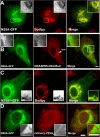
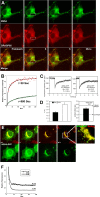

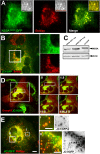
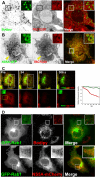
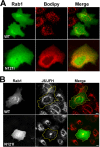
Similar articles
-
TBC1D20 is a Rab1 GTPase-activating protein that mediates hepatitis C virus replication.J Biol Chem. 2007 Dec 14;282(50):36354-61. doi: 10.1074/jbc.M705221200. Epub 2007 Sep 27. J Biol Chem. 2007. PMID: 17901050
-
Rab18 binds to hepatitis C virus NS5A and promotes interaction between sites of viral replication and lipid droplets.PLoS Pathog. 2013;9(8):e1003513. doi: 10.1371/journal.ppat.1003513. Epub 2013 Aug 1. PLoS Pathog. 2013. PMID: 23935497 Free PMC article.
-
Lipid droplet-binding protein TIP47 regulates hepatitis C Virus RNA replication through interaction with the viral NS5A protein.PLoS Pathog. 2013;9(4):e1003302. doi: 10.1371/journal.ppat.1003302. Epub 2013 Apr 11. PLoS Pathog. 2013. PMID: 23593007 Free PMC article.
-
Hepatitis C virus: viral proteins on the move.Biochem Soc Trans. 2009 Oct;37(Pt 5):986-90. doi: 10.1042/BST0370986. Biochem Soc Trans. 2009. PMID: 19754437 Review.
-
Phosphorylation of hepatitis C virus NS5A nonstructural protein: a new paradigm for phosphorylation-dependent viral RNA replication?Virology. 2007 Jul 20;364(1):1-9. doi: 10.1016/j.virol.2007.01.042. Epub 2007 Apr 2. Virology. 2007. PMID: 17400273 Review.
Cited by
-
Loss-of-function mutations in TBC1D20 cause cataracts and male infertility in blind sterile mice and Warburg micro syndrome in humans.Am J Hum Genet. 2013 Dec 5;93(6):1001-14. doi: 10.1016/j.ajhg.2013.10.011. Epub 2013 Nov 14. Am J Hum Genet. 2013. PMID: 24239381 Free PMC article.
-
Assembly and release of infectious hepatitis C virus involving unusual organization of the secretory pathway.World J Hepatol. 2016 Jul 8;8(19):796-814. doi: 10.4254/wjh.v8.i19.796. World J Hepatol. 2016. PMID: 27429716 Free PMC article.
-
Osteopontin Regulates Hepatitis C Virus (HCV) Replication and Assembly by Interacting with HCV Proteins and Lipid Droplets and by Binding to Receptors αVβ3 and CD44.J Virol. 2018 Jun 13;92(13):e02116-17. doi: 10.1128/JVI.02116-17. Print 2018 Jul 1. J Virol. 2018. PMID: 29669827 Free PMC article.
-
Hepatitis C virus NS5A protein cooperates with phosphatidylinositol 4-kinase IIIα to induce mitochondrial fragmentation.Sci Rep. 2016 Mar 24;6:23464. doi: 10.1038/srep23464. Sci Rep. 2016. PMID: 27010100 Free PMC article.
-
A novel mouse model of Warburg Micro syndrome reveals roles for RAB18 in eye development and organisation of the neuronal cytoskeleton.Dis Model Mech. 2014 Jun;7(6):711-22. doi: 10.1242/dmm.015222. Epub 2014 Apr 24. Dis Model Mech. 2014. PMID: 24764192 Free PMC article.
References
-
- Appel N, et al. 2008. Essential role of domain III of nonstructural protein 5A for hepatitis C virus infectious particle assembly. PLoS Pathog. 4:e1000035 doi:10.1371/journal.ppat.1000035 - DOI - PMC - PubMed
-
- Bartenschlager R, Penin F, Lohmann V, Andre P. 2011. Assembly of infectious hepatitis C virus particles. Trends Microbiol. 19:95–103 - PubMed
-
- Bartz R, et al. 2007. Dynamic activity of lipid droplets: protein phosphorylation and GTP-mediated protein translocation. J. Proteome Res. 6:3256–3265 - PubMed
-
- Boulant S, Targett-Adams P, McLauchlan J. 2007. Disrupting the association of hepatitis C virus core protein with lipid droplets correlates with a loss in production of infectious virus. J. Gen. Virol. 88:2204–2213 - PubMed
Publication types
MeSH terms
Substances
LinkOut - more resources
Full Text Sources
Other Literature Sources
Medical
Molecular Biology Databases

